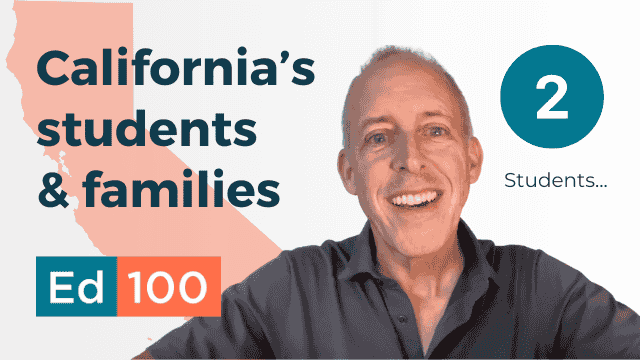
Children are vulnerable. A key role of government is to ensure that there are functioning systems to protect children from harm through neglect or abuse.
In This Lesson

What is child protective service?
What is foster care?
How are kids placed in foster care?
How many kids are in foster care?
Why have foster care placements declined?
How is California's foster care system different?
Why is LCFF important for foster youth?
Who serves as a foster family?
How long do kids stay in foster care?
What obstacles do foster kids face?
What happens to foster youth when they turn 18?
▶ Watch the video summary
★ Discussion Guide.
This lesson briefly explains the main systems that protect vulnerable children in California, including Child Protective Services (CPS) and foster care. School communities have a role to play in this important work.
What is Child Protective Services (CPS)?
When someone reports a concern involving a child to a police officer or other authority, the case is reported to Child Protective Services (CPS) to investigate it and take action. The systems that protect children from harm rely on people speaking up. The system deals with a very large volume of reports. One study in California found that 14% of children born in 2002 were reported for possible maltreatment by the age of five.
Education personnel are the single largest group of reporters of child maltreatment in the USA:
A report of possible maltreatment is the first step in a process of investigation and response. In California, child welfare services are a county function. On average, statewide, a caseworker responds to an allegation within a few days. The majority of allegations (just over half) are determined to be unsubstantiated, meaning that the caseworker concludes the evidence is insufficient to warrant further action. Of the substantiated cases, the largest number of involve girls and boys under the age of three, in about equal numbers. The main category of maltreatment is neglect.
The child protective system is complex, and varies from place to place. Like any system, it has its own terminology, which can be daunting. It's a human system, consisting of individual people with the difficult job of making hard decisions that deeply affect the lives of children and family members.
Every year, the Children's Bureau of the US Department of Health and Human Services prepares a Report to Congress with both national and state statistics. As with most government data, the latest numbers are always about three years out of date. According to the 2024 report of 2022 data, about 7.7 of every 1,000 children was a victim of neglect or abuse in 2022. The rate in California was similar to the national average.
What is foster care?
According to the Annie E. Casey Foundation (AECF), foster care is “a temporary living arrangement for kids whose parents cannot take care of them and whose need for care has come to the attention of child welfare staff. While in foster care, children may live with relatives, foster families or in group facilities.”
The foundation reports that “nearly half of kids who enter the foster care system return to their parent or primary caretaker.”
Foster care is disruptive. During their time in the system, children may be moved from one family or facility to another, often requiring them to switch schools. Foster care is provided by a combination of individual families and group settings. It's hard for learning to be the focus in that kind of chaos.
Why have foster care placements declined?
Over decades, fewer children have been placed into foster care, consistent with long-term efforts to connect and coordinate the many agencies connected with child welfare.
In 1997, the Adoption and Safe Families Act formalized a set of seven measurable goals for child welfare systems, and required an annual report to Congress to assess progress. Reducing the number of placements into foster care was among the goals. The Department of Health and Human Services publishes annual data collected from the states, including California.
The pandemic threw a wrench in the system, because many of the people normally in a position to notice and report maltreatment could not play that role.
Why is the school funding system important for education of foster youth?
California's public education funding system, the Local Control Funding Formula (LCFF) directs additional funds to school districts for high-need students, including foster youth. To be clear, LCFF doesn't provide funds directly to foster youth or their families — the funds go to the school district or charter school they attend. But it creates a formal reason for the system to take note of foster kids, who can be easily overlooked.
Students (or their caregivers) may qualify for support from other programs, like Social Security.
How long do kids stay in foster care?
Most placements into foster care are temporary, lasting less than a year before being reunited with a parent or caregiver. But each case is its own story.
When foster youth turn 18, they age out of the foster care system. Some teens opt to seek independence from their family earlier than age 18 by pursuing legal emancipation. It's rare. The opposite case exists, too: foster youth in California have the option to extend their care arrangements until age 21.
What are the obstacles faced by foster youth?
Students in foster care face major obstacles. According to The Invisible Achievement Gap, a series of extensive studies of foster care in California, compared to other subgroups of students foster youth were:
- Classified with a disability at a higher rate than comparison groups.
- More likely than other students to change schools during the school year.
- More likely than the general population of students to be enrolled in the lowest-performing schools.
- Most likely to drop out and least likely to graduate.
A disproportionate fraction of teens in foster care identify as LGBTQ+.
The Covid-19 pandemic presented particular challenges for foster youth, making problems already present within the system worse. Aging out of foster care became scarier than ever in a time of extreme uncertainty, and the transition to virtual schooling was tough for foster kids forced to change homes because of the pandemic conditions.
The California Department of Education intermittently offers a page that documents the rights of foster kids. The Foster Care Ombudsperson appears to be a more consistently available resource.
How to help
Fortunately, there are many ways to support foster children. You could adopt or foster a child. You could donate some time as a court-appointed special advocate (CASA) for one or more foster kids. There are smaller options, of course; nonprofit organizations are crucial sources of help for foster youth, and they need support.
Updated July 2025
CHAPTER 2:
Students...
-
Students...
Overview of Chapter 2 -
Diversity
The Changing Face of America's Students -
Poverty and Race
How Do Students' Backgrounds Affect Their School Performance? -
Health and Education
What Can Schools Do? -
The Role of Parents
Education and Families -
How Does Education Change
Inputs and Outcomes -
Motivation
What Motivates Students? -
Special Education
Why Not Teach All Kids Alike? -
Child Protection
Intervention and foster care -
Undocumented Students
Education vs. Documentation -
Student Leadership
Student Voice in Schools
Related
Sharing is caring!
Password Reset
Search all lesson and blog content here.
Login with Email
We will send your Login Link to your email
address. Click on the link and you will be
logged into Ed100. No more passwords to
remember!














Questions & Comments
To comment or reply, please sign in .
Carol Kocivar December 28, 2024 at 4:15 pm
Foster youth in California face systemic barriers that can interfere with their educational success, from K-12 instability to college challenges, with graduation rates and college enrollment far below state averages.
https://transformschools.ucla.edu/research/understanding-belongingness-support-and-perseverance-an-exploratory-study-of-the-educational-experiences-of-foster-youth-in-california/
Jeff Camp - Founder September 26, 2023 at 9:56 pm
Carol Kocivar May 15, 2022 at 3:38 pm
A step-by-step guide to meeting education challenges and improving outcomes for children and youth in foster care and on probation is now available for California schools.
https://allianceforchildrensrights.org/resources/foster-youth-education-toolkit/
Selisa Loeza October 22, 2021 at 9:26 pm
afrinier February 16, 2020 at 11:45 am
Jeff Camp January 20, 2017 at 6:52 pm
Carol Kocivar December 7, 2015 at 9:56 am
A new guide to improve education outcomes for children in foster care is available, focused on their most critical needs. The guide is designed to assist school administrators in meeting the goals of the Local Control Funding Formula (LCFF).
http://kids-alliance.org/wp-content/uploads/2015/11/FY_EdToolkit_2.0_FINAL.pdf
Carol Kocivar November 9, 2015 at 11:07 am
http://youthlaw.org/governor-brown-signs-bill-expanding-support-for-students-in-foster-care/
Joanne Bonner Leavitt November 4, 2015 at 12:57 am
jenzteam February 27, 2015 at 10:25 am
Jeff Camp - Founder February 27, 2015 at 4:01 pm
Jeff Camp - Founder February 23, 2015 at 10:02 pm